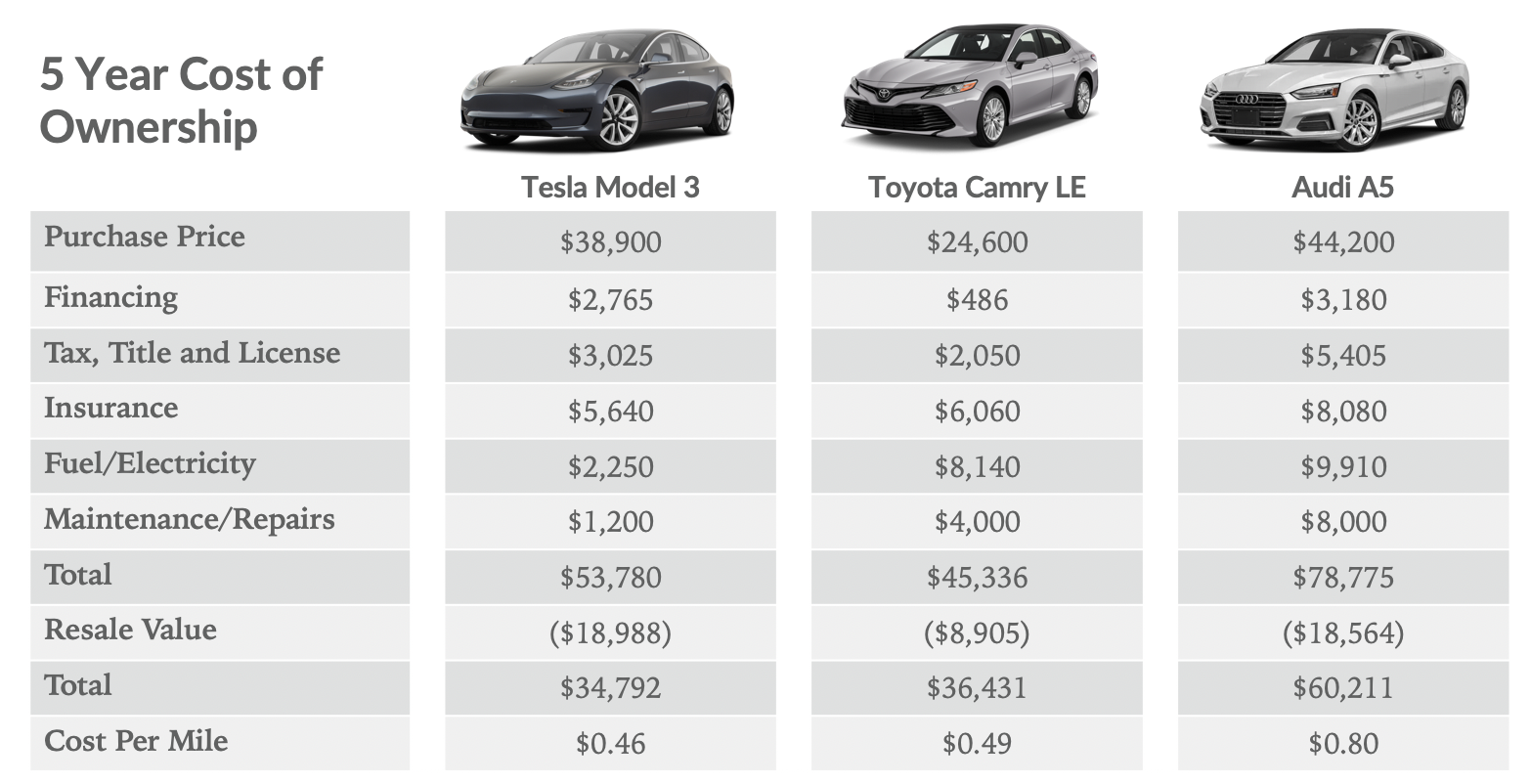Tesla Model 3 Cost of Ownership Slightly Cheaper Than a Camry
By Gene Munster
We’ve updated our 5-year cost of ownership study comparing a Tesla (TSLA) Model 3 to a Toyota Camry. The comparison gives us a look at how the Model 3 cost compares to a mass-market sedan. The original study from 2017 can be found here.
- In 2017, our model concluded that while the Model 3 value proposition was weighed down by a 40% sale price premium, it would end up costing 13% more to own and operate over 5 years than a Toyota Camry LE.
- In 2019, we found the purchase price gap has widened to 59% ($35k Model 3 has not come to fruition), but the cost of ownership gap has also widened to 18% from 13%.
- Importantly, factoring in the resale value of the two vehicles (benefit of an EV is their ability to retain value), the Model 3 becomes 5% cheaper on a cost per mile basis.
- The bottom line: Model 3 is a superior car (electric, safer, Autopilot) compared to a Camry, and is slightly cheaper to own and operate over 5 years.
- Average all-in cost per mile for a Model 3 is $0.46, compared to the Camry LE at $0.49, and Audi A5 at $0.80.

Here are the notable changes from the previous model:
- The Model 3 purchase price increased. Our previous model anticipated a $35K Model 3 would be in the market, which hasn’t came to fruition. The entry-level Model 3 today is $38,900.
- The Camry LE price was essentially unchanged.
- We’re now factoring in resale value in our model.
- Gas prices increased 16% since our 2017 study. We continue to expect a 5% annual increase.
- Model 3 insurance is lower by 9%.
- We are shifting to a finance option. Previously we used a lease option. This slightly and uniformly increased interest payments for each car.
Luxury Status
As the Model 3 is still considered to be a luxury sedan, we compared it to another luxury vehicle of similar cost. When compared to an Audi A5, the Model 3 was 12% cheaper upfront but over 5 years is 32% cheaper to operate (42% cheaper with resale value included). While we still believe the Model 3 has the perks of a luxury vehicle, it’s evident that it can maintain those features at a significantly lower cost.
Cost of Insurance
The cost difference between insuring a Tesla Model 3 and a Camry SE is less than you might think. The average cost per year of insuring a Tesla Model 3 is $1,128 today, while the average cost to insure a Camry SE is $1,212. Research suggests that Tesla Model 3s are categorized by insurance companies as luxury vehicles, while the Camry SE is not. Our estimates show that the first two years of insurance will run you about $100 a month, with the third and fourth year dropping to $90 a month. This price reduction is correlated with Tesla’s rumored internal insurance program which is projected to begin this summer in North America, as it has already launched in both Australia and China. The goal with Tesla’s insurance program is to match rates of the lowest competitor. We predict that the price to insure a Camry over the next 5 years will increase at a rate of 0.5%. Based on our model, we predict the average difference in insurance costs over a 5-year ownership span to be $420 less for a Tesla than a Camry.
The car insurance game itself is a data operation and there just isn’t enough current data on Tesla to justify the low insurance costs they should receive based on their safety ratings. We see this transformation happening in two ways; insurance companies who see the value in Tesla’s safety rating and lower their rate accordingly, and Tesla owners beginning to use Tesla’s branded insurance.
Looking to the Future
We believe that our model is conservative and that there is still room for the Model 3 to become even cheaper to own. We decided not to include the US EV tax credit due to the fact that it will be phased out completely by the end of this year. However, there is an opportunity for new incentives to be introduced. We believe Tesla will shed its status as a premium luxury vehicle that is contributing to higher insurance and financing rates. As EV ownership grows and there is more data on their cost, we expect the long-term value proposition to shine through.
 选择“Disable on www.wenxuecity.com”
选择“Disable on www.wenxuecity.com”
 选择“don't run on pages on this domain”
选择“don't run on pages on this domain”

